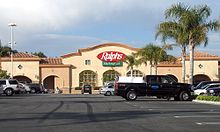
Ralphs
USINFO | 2013-11-29 15:51

A Ralphs Marketplace inPorter Ranch, Los Angeles, California

A typical Ralphs inTorrance, CA
Ralphs is a major supermarket chain in the Southern California area and the largest subsidiary of Cincinnati-based Kroger. It is the oldest such chain west of the Mississippi River. Ralphs also operates stores under the Food 4 Less and Foods Co. names in California.
History
Ralphs Grocery Company was founded in 1873 by George Albert Ralphs. The original store was located at Sixth and Spring Streets in Los Angeles, California. In the 20th century, Ralphs became a grocery pioneer, offering self-service markets with checkout stands in distributed locations. The company employed notable architects in designing its stores, and the former Ralphs Grocery Store building built in 1929 in Westwood Village has been photographed by Ansel Adams, declared a Historic Cultural Monument and listed in the National Register of Historic Places. In the 1980s, it created a chain of hybrid supermarket/warehouse stores called The Giant, which failed, but the concept returned with the company's merger with the Food 4 Lessdiscount chain. In 1994, Ralphs was acquired by the Yucaipa Companies for $1.5 billion. Yucaipa owned ABC Markets, Alpha Beta, Boys Markets, and Cala Foods. Soon, all ABC Markets, Alpha Betas and Boys Markets were rebranded as Ralphs. At the same time, Food 4 Less was merged with Ralphs. In 1997, Yucaipa sold the Ralphs Grocery Company to Fred Meyer, Inc., owner of several chains in the west. Soon, Ralphs Marketplace stores started opening; these stores are based on the Fred Meyer model but without apparel. In October 1998, the parent company, Fred Meyer, merged with The Kroger Company of Cincinnati, Ohio.In 1999, Ralphs purchased about 30 Albertsons and Lucky stores, mostly in northern California. The stores were divested as a result of the Albertsons and American Stores merger. Ralphs operated the stores until January 2006, when they announced that all but one Ralphs in northern California would close. In August 2006, the one remaining Ralphs in northern California was given a 60 day notice of closure. Also in August 2006, Ralphs finalized plans to sell 11 (of 13 remaining) Cala-BellStores to Harley DeLano, who previously ran the chain. Ralphs' expansion into northern California did not work out as previously thought.
On July 20, 2007, Ralphs opened a new 50,000-square-foot (4,600 m2) store on 9th and Hope St in the South Park neighborhood of Downtown Los Angeles. This was the first full-run supermarket in Downtown in 50 years. In 1950, Ralphs had closed a store at 7th Street and Figueroa.
Today, Ralphs competes with Albertsons, NorthGate Market, Vons, and Stater Bros. The current slogan is "Great food. Real Low Prices!". Ralphs is the current market leader in Southern California.
2003–2004 strike
On October 16, 2006, Ralphs agreed to pay $70 million to settle felony charges that it illegally rehired locked out employees using false names and social security numbers during the strike. Fifty million dollars of the settlement was to be paid to eligible UFCW members, with the remainder being paid in fines to the federal government.[2]
In popular culture
The photorealist painter Robert Cottingham depicted a Ralphs supermarket in his 1968 painting Ralph's II, currently on display in the Milwaukee Museum of Art.In the 1998 film The Big Lebowski, the character Jeff Lebowski's only form of identification is a Ralphs Club card. The film begins with Jeff Lebowski buying half and half at a Ralphs in Venice, CA.
In the 1992 film Forever Young Mel Gibson's character emerges from 50 year cryogenic sleep and attempts to returns to his house and finds a Ralph's supermarket in the house's former location. He makes a phone call on a pay phone in front of the store and mentions that his house is no longer there and some guy name Ralph (referring the store sign in the background) lives there.
The supermarket is featured in a scene in the 1973 film Messiah of Evil, first in an establishment shot from the parking lot, followed by a crucial scene from within.
The supermarket is also featured in a scene in the 1976 Walt Disney comedy film Gus, with Tom Bosley as Spinner and Tim Conway as his cohort in crime, Crankcase.
In the Buffy the Vampire Slayer episode "Pangs" (season 4, episode 8), Buffy Summers says " ... It was more like a riot than a Ralph's. I thought I was going to have to use Slayer moves on this one woman who was completely hoarding the pumpkin pie filling." [1]
In several episodes of the comedy podcast Welcome to Night Vale, events take place "in the hole in the vacant lot, out back of the Ralph's."
The song "Super Market" on Odd Future rapper Domo Genesis' album, Rolling Papers, takes place in a Ralph's supermarket. It features an argument between fellow Odd Future member Tyler, The Creatorand himself.
Share this page




















